key battery FIAT DUCATO 2018 Owner handbook (in English)
[x] Cancel search | Manufacturer: FIAT, Model Year: 2018, Model line: DUCATO, Model: FIAT DUCATO 2018Pages: 304, PDF Size: 14.93 MB
Page 4 of 304

READ THIS CAREFULLY
REFUELLING
Only refuel with automotive diesel conforming to the European specification EN590. The use of other products or mixtures may damage the
engine beyond repair and consequently invalidate the warranty, due to the damage caused.
STARTING THE ENGINE
Make sure that the handbrake is engaged; set the gear lever to neutral; fully depress the clutch pedal without pressing the accelerator, then
turn the ignition key to MAR-ON and wait for the warning lightsandto switch off; turn the ignition key to AVV and release it as soon
as the engine has started.
PARKING ON FLAMMABLE MATERIAL
The catalytic converter develops high temperatures during operation. Do not park on grass, dry leaves, pine needles or other flammable
material: fire hazard.
RESPECTING THE ENVIRONMENT
The vehicle is fitted with a system that allows continuous diagnosis of the emission-related components in order to help protect the
environment.
ELECTRICAL ACCESSORIES
If, after buying the vehicle, you decide to add electrical accessories (with the risk of gradually draining the battery), visit a Fiat Dealership. They
can calculate the overall electrical requirement and check that the vehicle's electrical system can support the required load.
SCHEDULED SERVICING
Correct maintenance enables the vehicle to perfectly maintain performance and safety characteristics, its environmental friendliness and low
running costs over time.
THE OWNER HANDBOOK CONTAINS
... important information, advice and warnings for correct use, driving safety and maintenance of your vehicle over time. Special attention
must be paid to the symbols(safety of persons)(environmental protection)(vehicle integrity).
Page 18 of 304
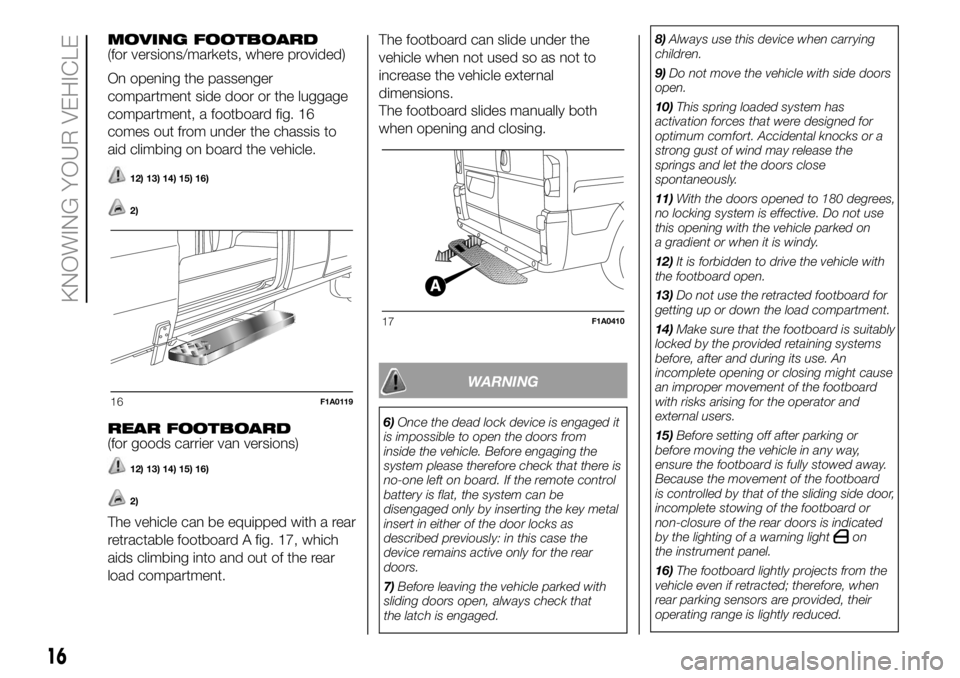
MOVING FOOTBOARD
(for versions/markets, where provided)
On opening the passenger
compartment side door or the luggage
compartment, a footboard fig. 16
comes out from under the chassis to
aid climbing on board the vehicle.
12) 13) 14) 15) 16)
2)
REAR FOOTBOARD
(for goods carrier van versions)
12) 13) 14) 15) 16)
2)
The vehicle can be equipped with a rear
retractable footboard A fig. 17, which
aids climbing into and out of the rear
load compartment.The footboard can slide under the
vehicle when not used so as not to
increase the vehicle external
dimensions.
The footboard slides manually both
when opening and closing.
WARNING
6)Once the dead lock device is engaged it
is impossible to open the doors from
inside the vehicle. Before engaging the
system please therefore check that there is
no-one left on board. If the remote control
battery is flat, the system can be
disengaged only by inserting the key metal
insert in either of the door locks as
described previously: in this case the
device remains active only for the rear
doors.
7)Before leaving the vehicle parked with
sliding doors open, always check that
the latch is engaged.8)Always use this device when carrying
children.
9)Do not move the vehicle with side doors
open.
10)This spring loaded system has
activation forces that were designed for
optimum comfort. Accidental knocks or a
strong gust of wind may release the
springs and let the doors close
spontaneously.
11)With the doors opened to 180 degrees,
no locking system is effective. Do not use
this opening with the vehicle parked on
a gradient or when it is windy.
12)It is forbidden to drive the vehicle with
the footboard open.
13)Do not use the retracted footboard for
getting up or down the load compartment.
14)Make sure that the footboard is suitably
locked by the provided retaining systems
before, after and during its use. An
incomplete opening or closing might cause
an improper movement of the footboard
with risks arising for the operator and
external users.
15)Before setting off after parking or
before moving the vehicle in any way,
ensure the footboard is fully stowed away.
Because the movement of the footboard
is controlled by that of the sliding side door,
incomplete stowing of the footboard or
non-closure of the rear doors is indicated
by the lighting of a warning light
on
the instrument panel.
16)The footboard lightly projects from the
vehicle even if retracted; therefore, when
rear parking sensors are provided, their
operating range is lightly reduced.
16F1A0119
17F1A0410
16
KNOWING YOUR VEHICLE
Page 33 of 304
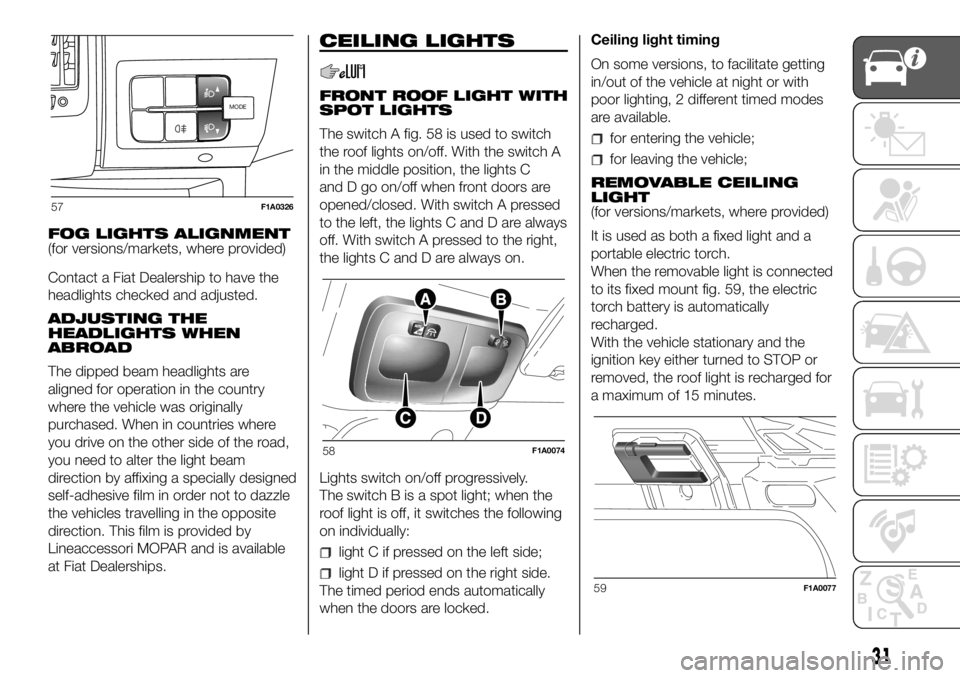
FOG LIGHTS ALIGNMENT
(for versions/markets, where provided)
Contact a Fiat Dealership to have the
headlights checked and adjusted.
ADJUSTING THE
HEADLIGHTS WHEN
ABROAD
The dipped beam headlights are
aligned for operation in the country
where the vehicle was originally
purchased. When in countries where
you drive on the other side of the road,
you need to alter the light beam
direction by affixing a specially designed
self-adhesive film in order not to dazzle
the vehicles travelling in the opposite
direction. This film is provided by
Lineaccessori MOPAR and is available
at Fiat Dealerships.
CEILING LIGHTS
FRONT ROOF LIGHT WITH
SPOT LIGHTS
The switch A fig. 58 is used to switch
the roof lights on/off. With the switch A
in the middle position, the lights C
and D go on/off when front doors are
opened/closed. With switch A pressed
to the left, the lights C and D are always
off. With switch A pressed to the right,
the lights C and D are always on.
Lights switch on/off progressively.
The switch B is a spot light; when the
roof light is off, it switches the following
on individually:
light C if pressed on the left side;
light D if pressed on the right side.
The timed period ends automatically
when the doors are locked.Ceiling light timing
On some versions, to facilitate getting
in/out of the vehicle at night or with
poor lighting, 2 different timed modes
are available.
for entering the vehicle;
for leaving the vehicle;
REMOVABLE CEILING
LIGHT
(for versions/markets, where provided)
It is used as both a fixed light and a
portable electric torch.
When the removable light is connected
to its fixed mount fig. 59, the electric
torch battery is automatically
recharged.
With the vehicle stationary and the
ignition key either turned to STOP or
removed, the roof light is recharged for
a maximum of 15 minutes.
MODEMODE
57F1A0326
58F1A0074
59F1A0077
31
Page 35 of 304

PARKING LIGHTS
These lights can only be turned on with
ignition key in the STOP position or
removed by moving the left stalk ring
first to theOposition and then to the
orposition. Thewarning
light switches on in the instrument
panel.
ECO FUNCTION
(For versions/markets, where provided)
Press theECObutton fig. 63 to enable
this function. When the function is
enabled, the corresponding LED on the
button turns on together with an icon
and a message on the display.
This function is memorised, so when
the vehicle is started again, the system
keeps the setting it had before the
engine was stopped. Press theECO
button again to disable the function and
restore the normal driving setting.In the event of a malfunction with the
function on, the system automatically
disables theECOfunction and restores
the normal driving setting.
HEATED REAR WINDOW
(for versions/markets, where provided)
Press button A fig. 64 to enable. The
device will be switched off automatically
after approximately 20 minutes.
BATTERY
DISCONNECTION
FUNCTION
(DISCONNECTOR)
(for versions/markets, where provided)
The battery disconnection function is
enabled with the ignition key in the
BATT position, as illustrated on the
dedicated plate located in the area
shown in fig. 65.
To turn the ignition key to BATT
position, press the button A (red) fig.
66.The battery will be disconnected, by
interrupting the earth lead, about 7
minutes after the key is turned to the
BATT position.
This 7 minute period is necessary to:
allow the driver to get out of the
vehicle and lock the doors using the
remote control;
guarantee that all the vehicle
electrical systems have been
deactivated.
MODE
63F1A0438
64F1A0330
65F1A0082
66F1A0083
33
Page 36 of 304
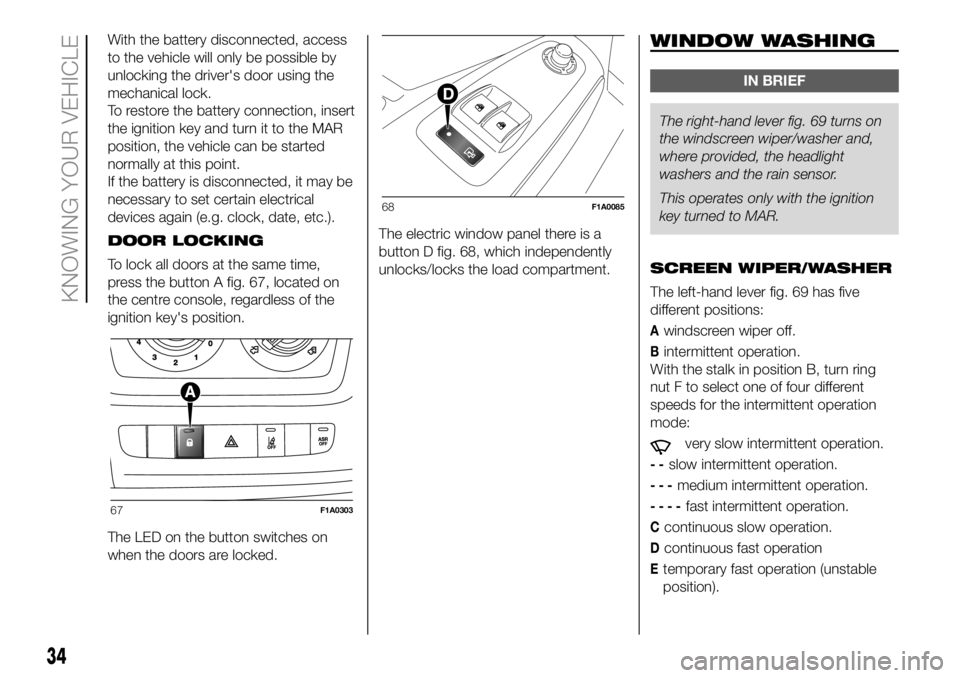
With the battery disconnected, access
to the vehicle will only be possible by
unlocking the driver's door using the
mechanical lock.
To restore the battery connection, insert
the ignition key and turn it to the MAR
position, the vehicle can be started
normally at this point.
If the battery is disconnected, it may be
necessary to set certain electrical
devices again (e.g. clock, date, etc.).
DOOR LOCKING
To lock all doors at the same time,
press the button A fig. 67, located on
the centre console, regardless of the
ignition key's position.
The LED on the button switches on
when the doors are locked.The electric window panel there is a
button D fig. 68, which independently
unlocks/locks the load compartment.WINDOW WASHING
IN BRIEF
The right-hand lever fig. 69 turns on
the windscreen wiper/washerand,
where provided, the headlight
washers and the rain sensor.
This operates only with the ignition
key turned to MAR.
SCREEN WIPER/WASHER
The left-hand lever fig. 69 has five
different positions:
Awindscreen wiper off.
Bintermittent operation.
With the stalk in position B, turn ring
nut F to select one of four different
speeds for the intermittent operation
mode:
very slow intermittent operation.
--slow intermittent operation.
---medium intermittent operation.
----fast intermittent operation.
Ccontinuous slow operation.
Dcontinuous fast operation
Etemporary fast operation (unstable
position).
67F1A0303
68F1A0085
34
KNOWING YOUR VEHICLE
Page 65 of 304
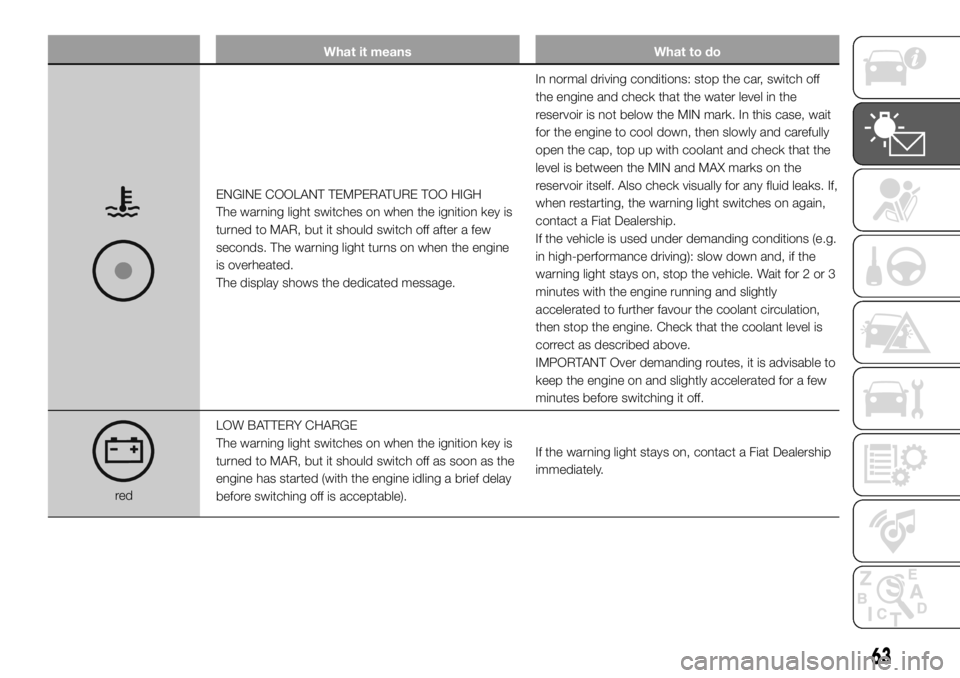
What it means What to do
ENGINE COOLANT TEMPERATURE TOO HIGH
The warning light switches on when the ignition key is
turned to MAR, but it should switch off after a few
seconds. The warning light turns on when the engine
is overheated.
The display shows the dedicated message.In normal driving conditions: stop the car, switch off
the engine and check that the water level in the
reservoir is not below the MIN mark. In this case, wait
for the engine to cool down, then slowly and carefully
open the cap, top up with coolant and check that the
level is between the MIN and MAX marks on the
reservoir itself. Also check visually for any fluid leaks. If,
when restarting, the warning light switches on again,
contact a Fiat Dealership.
If the vehicle is used under demanding conditions (e.g.
in high-performance driving): slow down and, if the
warning light stays on, stop the vehicle. Wait for 2 or 3
minutes with the engine running and slightly
accelerated to further favour the coolant circulation,
then stop the engine. Check that the coolant level is
correct as described above.
IMPORTANT Over demanding routes, it is advisable to
keep the engine on and slightly accelerated for a few
minutes before switching it off.
redLOW BATTERY CHARGE
The warning light switches on when the ignition key is
turned to MAR, but it should switch off as soon as the
engine has started (with the engine idling a brief delay
before switching off is acceptable).If the warning light stays on, contact a Fiat Dealership
immediately.
63
Page 122 of 304
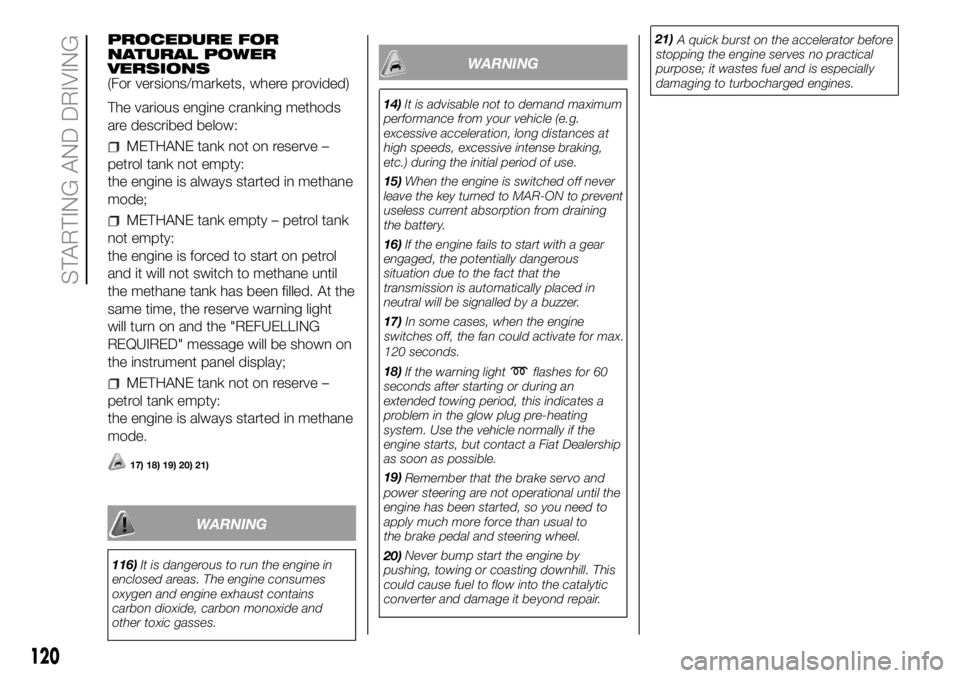
PROCEDURE FOR
NATURAL POWER
VERSIONS
(For versions/markets, where provided)
The various engine cranking methods
are described below:
METHANE tank not on reserve –
petrol tank not empty:
the engine is always started in methane
mode;
METHANE tank empty – petrol tank
not empty:
the engine is forced to start on petrol
and it will not switch to methane until
the methane tank has been filled. At the
same time, the reserve warning light
will turn on and the "REFUELLING
REQUIRED" message will be shown on
the instrument panel display;
METHANE tank not on reserve –
petrol tank empty:
the engine is always started in methane
mode.
17) 18) 19) 20) 21)
WARNING
116)It is dangerous to run the engine in
enclosed areas. The engine consumes
oxygen and engine exhaust contains
carbon dioxide, carbon monoxide and
other toxic gasses.
WARNING
14)It is advisable not to demand maximum
performance from your vehicle (e.g.
excessive acceleration, long distances at
high speeds, excessive intense braking,
etc.) during the initial period of use.
15)When the engine is switched off never
leave the key turned to MAR-ON to prevent
useless current absorption from draining
the battery.
16)If the engine fails to start with a gear
engaged, the potentially dangerous
situation due to the fact that the
transmission is automatically placed in
neutral will be signalled by a buzzer.
17)
If the warning light
flashes for 60
seconds after starting or during an
extended towing period, this indicates a
problem in the glow plug preheating
system. Use the vehicle normally if the
engine starts, but contact a Fiat Dealership
as soon as possible. 18)
Remember that the brake servo and
power steering are not operational until the
engine has been started, so you need to
apply much more force than usual to
the brake pedal and steering wheel. 19)
Never bump start the engine by
pushing, towing or coasting downhill. This
could cause fuel to flow into the catalytic
converter and damage it beyond repair. 20)A quick burst on the accelerator before
stopping the engine serves no practical
purpose; it wastes fuel and is especially
damaging to turbocharged engines. 21)
In some cases, when the engine
switches off, the fan could activate for max.
120 seconds.
120
STARTING AND DRIVING
Page 123 of 304
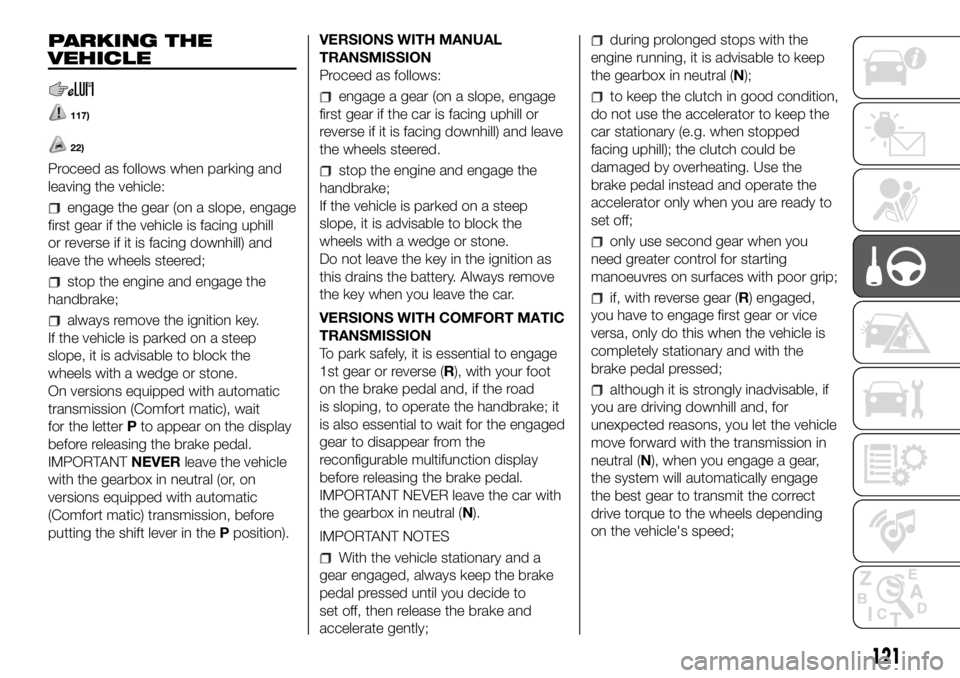
PARKING THE
VEHICLE
117)
22)
Proceed as follows when parking and
leaving the vehicle:
engage the gear (on a slope, engage
first gear if the vehicle is facing uphill
or reverse if it is facing downhill) and
leave the wheels steered;
stop the engine and engage the
handbrake;
always remove the ignition key.
If the vehicle is parked on a steep
slope, it is advisable to block the
wheels with a wedge or stone.
On versions equipped with automatic
transmission (Comfort matic), wait
for the letterPto appear on the display
before releasing the brake pedal.
IMPORTANTNEVERleave the vehicle
with the gearbox in neutral (or, on
versions equipped with automatic
(Comfort matic) transmission, before
putting the shift lever in thePposition).VERSIONS WITH MANUAL
TRANSMISSION
Proceed as follows:
engage a gear (on a slope, engage
first gear if the car is facing uphill or
reverse if it is facing downhill) and leave
the wheels steered.
stop the engine and engage the
handbrake;
If the vehicle is parked on a steep
slope, it is advisable to block the
wheels with a wedge or stone.
Do not leave the key in the ignition as
this drains the battery. Always remove
the key when you leave the car.
VERSIONS WITH COMFORT MATIC
TRANSMISSION
To park safely, it is essential to engage
1st gear or reverse (R), with your foot
on the brake pedal and, if the road
is sloping, to operate the handbrake; it
is also essential to wait for the engaged
gear to disappear from the
reconfigurable multifunction display
before releasing the brake pedal.
IMPORTANT NEVER leave the car with
the gearbox in neutral (N).
IMPORTANT NOTES
With the vehicle stationary and a
gear engaged, always keep the brake
pedal pressed until you decide to
set off, then release the brake and
accelerate gently;
during prolonged stops with the
engine running, it is advisable to keep
the gearbox in neutral (N);
to keep the clutch in good condition,
do not use the accelerator to keep the
car stationary (e.g. when stopped
facing uphill); the clutch could be
damaged by overheating. Use the
brake pedal instead and operate the
accelerator only when you are ready to
set off;
only use second gear when you
need greater control for starting
manoeuvres on surfaces with poor grip;
if, with reverse gear (R) engaged,
you have to engage first gear or vice
versa, only do this when the vehicle is
completely stationary and with the
brake pedal pressed;
although it is strongly inadvisable, if
you are driving downhill and, for
unexpected reasons, you let the vehicle
move forward with the transmission in
neutral (N), when you engage a gear,
the system will automatically engage
the best gear to transmit the correct
drive torque to the wheels depending
on the vehicle's speed;
121
Page 127 of 304
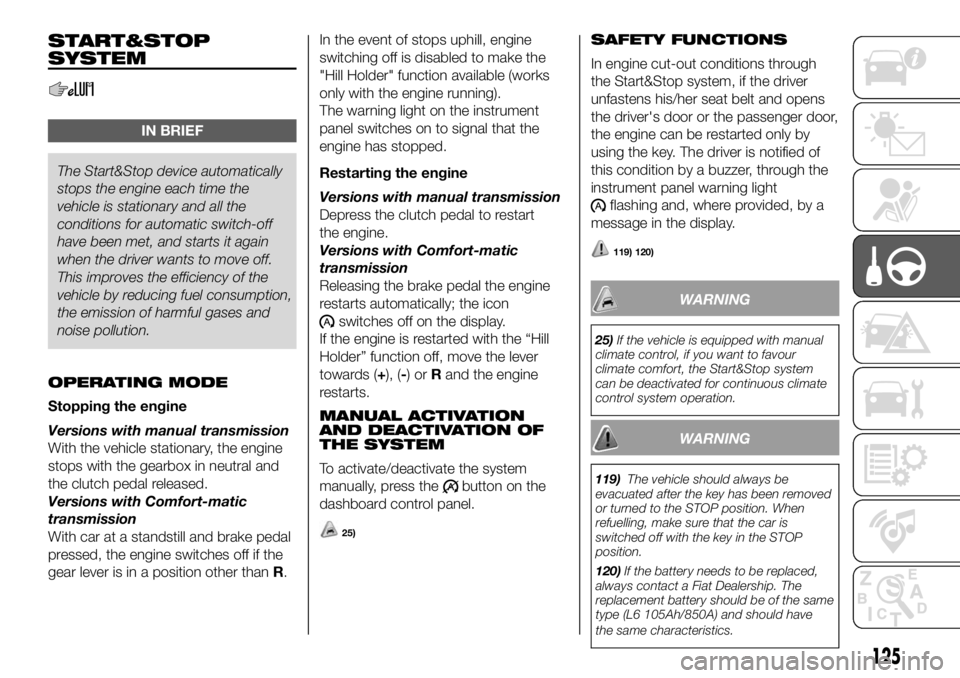
START&STOP
SYSTEM
IN BRIEF
The Start&Stop device automatically
stops the engineeach time the
vehicle is stationary and all the
conditions for automatic switch-off
have been met, and starts it again
when the driver wants to move off.
This improves the efficiency of the
vehicle by reducing fuel consumption,
the emission of harmful gases and
noise pollution.
OPERATING MODE
Stopping the engine
Versions with manual transmission
With the vehicle stationary, the engine
stops with the gearbox in neutral and
the clutch pedal released.
Versions with Comfort-matic
transmission
With car at a standstill and brake pedal
pressed, the engine switches off if the
gear lever is in a position other thanR.In the event of stops uphill, engine
switching off is disabled to make the
"Hill Holder" function available (works
only with the engine running).
The warning light on the instrument
panel switches on to signal that the
engine has stopped.
Restarting the engine
Versions with manual transmission
Depress the clutch pedal to restart
the engine.
Versions with Comfort-matic
transmission
Releasing the brake pedal the engine
restarts automatically; the icon
switches off on the display.
If the engine is restarted with the “Hill
Holder” function off, move the lever
towards (+), (-)orRand the engine
restarts.
MANUAL ACTIVATION
AND DEACTIVATION OF
THE SYSTEM
To activate/deactivate the system
manually, press the
button on the
dashboard control panel.
25)
SAFETY FUNCTIONS
In engine cut-out conditions through
the Start&Stop system, if the driver
unfastens his/her seat belt and opens
the driver's door or the passenger door,
the engine can be restarted only by
using the key. The driver is notified of
this condition by a buzzer, through the
instrument panel warning light
flashing and, where provided, by a
message in the display.
119) 120)
WARNING
25)If the vehicle is equipped with manual
climate control, if you want to favour
climate comfort, the Start&Stop system
can be deactivated for continuous climate
control system operation.
WARNING
119)The vehicle should always be
evacuated after the key has been removed
or turned to the STOP position. When
refuelling, make sure that the car is
switched off with the key in the STOP
position.
120)If the battery needs to be replaced,
always contact a Fiat Dealership. The
replacement battery should be of the same
type (L6 105Ah/850A) and should have
the same characteristics.
125
Page 149 of 304

PROLONGED
VEHICLE INACTIVITY
If the vehicle needs to be off the road
for longer than one month, the following
precautions must be taken:
park the vehicle indoors in a dry
and, if possible, well-ventilated place;
engage a gear;
check that the handbrake is not
engaged;
disconnect the negative battery
terminal; if the vehicle is equipped with
a battery disconnection function
(disconnector), see the description of
the procedure in the "Controls"
paragraph in the "Dashboard and
controls" section;
clean and protect the painted parts
using protective wax;
clean and protect the shiny metal
parts using special compounds
available commercially;
sprinkle talcum powder on the
windscreen and rear window wiper
rubber blades and lift them off the
glass;
slightly open the windows;
cover the vehicle with a piece of
fabric or perforated plastic sheet. Do
not use compact plastic tarpaulins,
which prevent humidity from
evaporating from the surface of the
vehicle;
inflate tyres to +0.5 bar above the
standard specified pressure and check
it at intervals;
do not drain the engine cooling
system.
IMPORTANT If the vehicle is equipped
with an alarm system, switch off the
vehicle alarm with the remote control.
IMPORTANT After turning the ignition
key to STOP and having closed the
driver side door, wait at least one
minute before disconnecting the
electrical supply from the battery. When
reconnecting the electrical supply to
the battery, make sure that the ignition
key is in the STOP position and the
driver side door is closed.
147